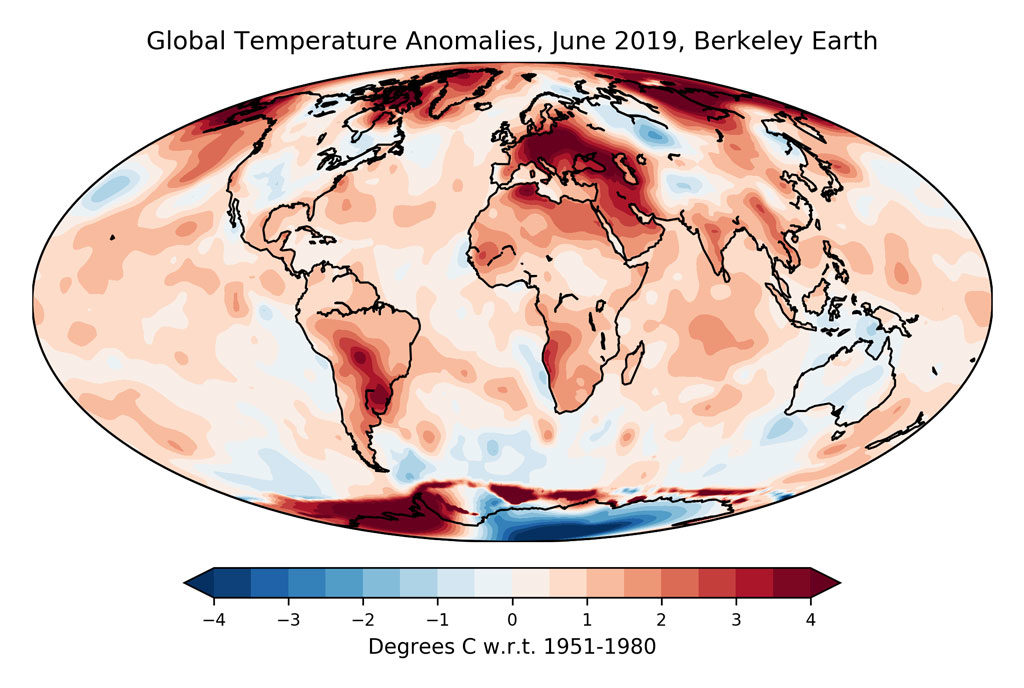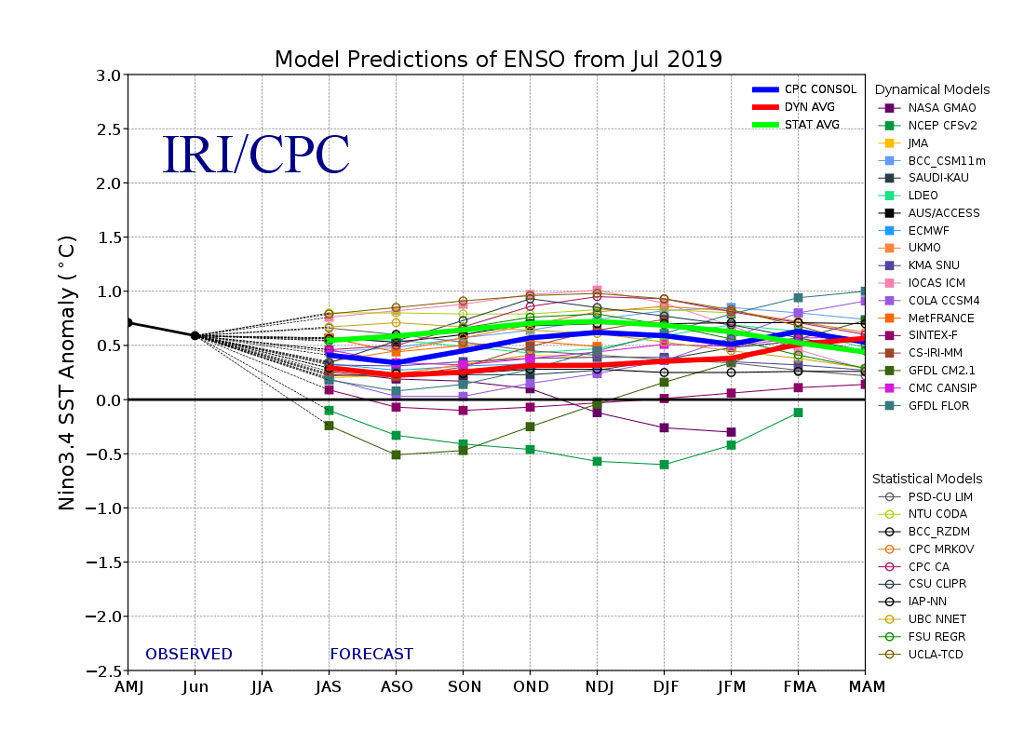
State of the climate: 2019 set to be second or third warmest year
Zeke Hausfather
07.25.19Zeke Hausfather
25.07.2019 | 2:50pmWith the data now in for the first half of the year, Carbon Brief estimates that 2019 is most likely to be either the second or third warmest year on record for the Earth’s surface, depending on the approach used to calculate global temperatures.
Global surface temperatures have been quite warm over the first half of 2019, driven by increasing atmospheric greenhouse gas concentrations and assisted by a weak El Niño event in the tropical Pacific. June 2019 was the warmest June since records began in 1850, and July 2019 is likely to be both the warmest July on record and the single warmest month ever recorded.
While there is still some uncertainty as to how the remaining six months will play out, it is extremely unlikely that 2019 will displace 2016 as the warmest year on record, and also very unlikely that this year will place lower than the fourth warmest on record.
Arctic sea ice has been at a record or near-record low extent for the past four months, though it is still too early to tell if the summer minimum in September will see a new record low extent. Arctic sea ice volume is currently tied with 2012 and 2017 for the lowest value on record.
Antarctic sea ice extent has generally been on the low-end of normal for the first half of 2019, and global sea ice has also been at record low levels over the past four months.
Record summer warmth
Summer 2019 has seen record-setting heatwaves in a number of regions, including the continental US, Europe and Alaska. Record-breaking heat in France in late June, for example, was shown to have been made “at least five times more likely” by climate change. June 2019 was the warmest June on record for the world as a whole, adding to an already exceptionally warm start to the year.
The map below shows the departure from normal temperatures during the month of June, based on data from Berkeley Earth, where normal conditions are defined as the average June during the period from 1951-1980.

June 2019 average surface temperatures from Berkeley Earth. Anomalies plotted with respect to the 1951-1980 baseline used by Berkeley Earth. Chart by Carbon Brief.
June saw exceptional heat over much of Europe, northern Africa, South America, Siberia and Greenland. The Antarctic peninsula was also quite warm, though parts of central Antarctica saw unusually cold temperatures in June.
July has also been quite warm to-date globally in reanalysis products – near-real-time estimates based on a combination of measurements and a weather model – and looks likely to set a record as both the warmest July and the warmest month in recorded history for the globe in terms of absolute temperatures. However, differences are large enough between reanalysis products and slower-reporting surface temperature based products that it is too early to know for sure that July will set a record across all the different groups that provide surface temperature estimates.
While human emissions of CO2 and other greenhouse gases are responsible for all of the Earth’s long-term warming, temperatures in any given year are strongly influenced by short-term variations in the Earth’s climate are associated with El Niño and La Niña events. These are fluctuations in temperature between the ocean and atmosphere in the tropical Pacific which help to make some years warmer and some cooler.
The first half of 2019 saw mild El Niño conditions, helping boost spring and summer warmth. Prediction models offer mixed estimates of what will happen to El Niño in the second half of the year; physics-based dynamical models tend to show neutral conditions – where tropical Pacific temperatures are less than 0.5C above normal – while statistical models tend to show the continuation of mild El Niño conditions.
The figure below shows a range of different El Niño forecast models produced by different scientific groups. The values shown are sea surface temperature variations in the tropical Pacific – the El Niño 3.4 region – for three month periods. The average of dynamical models is shown in red while that for statistical models in shown in green.

El Niño Southern Oscillation (ENSO) forecast models for three-month periods in the Niño3.4 region (April, May, June – AMJ – and so on), taken from the CPC/IRI ENSO forecast.
Tied for the second warmest first six months
While summer of 2019 has been exceptionally warm so far, nearly every month in the first half of the year has seen near-record high temperatures. The average temperature over the first six months of the year is tied with 2017 for the second warmest on record, with the “super El Nino”-boosted 2016 still the clear record holder.
The figure below shows how temperatures so far in 2019 (red line) compare to prior years (grey lines) in the NASA GISTEMP dataset (using its new version 4). It shows the temperature of the year-to-date for each month of the year, from January through the full annual average.
Year-to-date temperatures for each month from 2012 to 2019 from NASA GISTemp. Anomalies plotted with respect to a 1981-2010 baseline. Chart by Carbon Brief using Highcharts.In the NASA dataset, 2019 ties for the second warmest January-June average on record. However, both of the other record years had lower temperatures in the second half of the year, while 2019 has remained quite warm in June and July.
The map below shows the distribution of temperatures in the first six months of 2019 over the world. The Arctic has been strikingly warm so far this year, with many areas 3C warmer than the global average. Europe has also experienced unusual warmth of about 2C above average, while the US has been a bit cooler than the rest of the globe over the first six months of 2019. Other unusually warm locations include southern Africa, Australia, and parts of south-east Asia.

Average surface temperatures over the first six months of 2019 (January through June) from Berkeley Earth. Anomalies plotted with respect to the 1951-1980 baseline used by Berkeley Earth. Chart by Carbon Brief.
The cool patch south of Greenland is also notable, as it has been a persistent feature over the past few decades. A number of papers have suggested that cooling in that region is due to large-scale ice melt in Greenland slowing down the Atlantic overturning circulation.
On track for second or third warmest year
Global surface temperatures are reported by a number of different international groups of scientists, including NASA, NOAA, NOAA, Berkeley Earth, Cowtan and Way and Copernicus/ECMWF.
With half the year’s data recorded and forecasts of El Nino development over the next six months now published, it is possible to estimate with reasonable accuracy where 2019 annual temperatures will likely end up.
Carbon Brief has examined global surface temperature data all six groups, and projected temperatures for the full year of 2019 using the data available to-date for each dataset, along with projection of the El Niño Index for the remainder of 2019 (see methodological note at the end for details).
The results are shown in the figure below. Annual temperatures from 1970-2018 are shown in black for each record, while the likely range (95% confidence interval) of the 2019 annual temperature based on the first six months of the year is shown by the red bar.
Annual global mean surface temperatures and 2019 estimates from NASA GISTemp, NOAA GlobalTemp, Hadley/UEA HadCRUT4, Berkeley Earth and Copernicus/ECMWF. Anomalies plotted with respect to a 1981-2010 baseline. See methodological note below for details. Chart by Carbon Brief using Highcharts.For all surface temperature records, 2019 will most likely be either the second or third warmest on record. Carbon brief estimates that four groups – NASA, Cowtan and Way, Berkeley Earth, and Copernicus – will likely have 2019 as the second warmest year on record after 2016, while the Met Office Hadley Centre/UEA record will likely have 2019 as the third warmest after 2016 and 2015. The NOAA record has 2019 anywhere from second to fourth warmest, with second warmest the most likely outcome between the three.
These groups differ in how they correct for changes in measurement approaches over time and how they fill in gaps between measurements. Records with more limited coverage of the fast-warming Arctic – such as Hadley/UEA and NOAA – tend to predict somewhat cooler 2019 temperatures.
The probability of where 2019 will fall on the leaderboard of warmest years based temperatures so far this year is shown in the table below.
Where will 2019 likely fall in the list of warmest years?
| NASA GISTEMP | Hadley/UEA HadCRUT4 | NOAA GlobalTemp | Berkeley Earth | Cowtan&Way | Copernicus | |
|---|---|---|---|---|---|---|
| 1st | 4% | 0% | 2% | 1% | 0% | 6% |
| 2nd | 71% | 2% | 42% | 69% | 55% | 68% |
| 3rd | 15% | 75% | 27% | 17% | 23% | 26% |
| 4th | 9% | 23% | 29% | 11% | 20% | 0% |
| 5th | 0% | 0% | 0% | 1% | 1% | 0% |
There is very little chance that 2019 will beat 2016 as the warmest year on record, and almost no chance that it will be cooler than last year (2018) and slip into fifth place.
In-line with climate model projections
Climate models provide physics-based estimates of future warming given different assumptions about future emissions, greenhouse gas concentrations and other climate-influencing factors.
Model estimates of temperatures prior to 2005 are a “hindcast” using known past climate influences, while temperatures projected after 2005 are a “forecast” based on an estimate of how things might change.
The figure below shows the range of individual models forecasts featured in the Intergovernmental Panel on Climate Change’s (IPCC) fifth assessment report – known collectively as the CMIP5 models – between 1970 and 2020 with grey shading and the average projection across all the models shown in black. Individual observational temperature records are represented by coloured lines.
12-month average global average surface temperatures from CMIP5 models and observations between 1970 and 2020. Models use RCP4.5 forcings after 2005. They include sea surface temperatures over oceans and surface air temperatures over land to match what is measured by observations. Anomalies plotted with respect to a 1981-2010 baseline. Chart by Carbon Brief using Highcharts.While global temperatures were running a bit below the pace of warming projected by climate models between 2005 and 2014, the last few years have been pretty close to the model average. This is particularly true for globally-complete temperature records such as NASA, Berkeley Earth and the Copernicus/ECMWF reanalysis that include temperature estimates for the whole Arctic. In recent months, temperatures have been ticking back upward toward the model average.
Record lows for Arctic sea ice
Sea ice extent has been at record lows in the Arctic and quite low in the Antarctic for much of the year, driven by warm temperatures in the region. The figure below shows both Arctic and Antarctic sea ice extent in 2019 – solid red and blue lines – the historical range in the record between 1979 and 2010 – shaded areas – and the record lows – dotted black line.
Arctic and Antarctic daily sea ice extent from the US National Snow and Ice Data Center. The bold lines show daily 2019 values, the shaded area indicates the two standard deviation range in historical values between 1979 and 2010. The dotted black lines show the record lows for each pole. Chart by Carbon Brief using Highcharts.Arctic sea ice spent much of early 2019 at the low end of the historical range and has set new record lows for the time of year over the past four months. Antarctic sea ice hit record lows in early January, recovered a bit in the early spring, and returned to record or near-record lows between April and July.
The summer Arctic sea ice minimum is a somewhat iconic figure, and recent years have yet to surpass the record low set in 2012. While Arctic sea ice is currently at record lows for this time of year, it is unclear if these conditions will persist and it is still too early to know where the 2019 minimum will fall.
The chart below shows the average Arctic sea ice extent for each week of the year for every year between 1978 and 2019, with 2019 to-date highlighted with a thick black line. (Prior to 1978, satellite measurements of sea ice extent are not available and the data is much less reliable.)
Arctic and Antarctic weekly sea ice extent from the US National Snow and Ice Data Center from 1979 through April 2019.The figure shows a clear and steady decline in Arctic sea ice since the late 1970s, with darker colours (earlier years) at the top and lighter colors (more recent years) much lower. A typical summer now has nearly half as much sea ice in the Arctic as it had in the 1970s and 1980s.
Sea ice extent only tells part of the story about changes at the poles; thickness (and volume) are also important variables, though they are more difficult to measure. The Pan-Arctic Ice Ocean Modeling and Assimilation System (PIOMAS) project provides estimates of Arctic sea ice volume since 1979, shown in the figure below.

Arctic sea-ice volume anomalies from 1979 through 2019 from PIOMAS.
Sea ice volume shows a clear downward trend, and 2019 is currently tied with 2012 and 2017 for the lowest volume on record.
Global sea ice extent – which includes both Arctic and Antarctic regions – has also seen record low levels in recent months. Global sea ice changes tend to be much smaller than changes seen at either pole, as Antarctic sea ice is growing while Arctic sea ice is shrinking and vice versa due to the different seasons in each hemisphere.
Methodological note
A statistical multivariate regression model was used to estimate the range of likely 2019 annual temperatures for each group that provides a temperature record. This model used the average temperature over first six months of the year, the latest monthly temperature value (June 2019), the average ENSO 3.4 region value during the first six months of the year and the average predicted ENSO 3.4 value during the last six months of the year to estimate the annual temperatures. The model was trained on the relationship between these variables and annual temperatures over the period from 1950 through 2018 (or 1979 through 2018 for the Copernicus/ECMWF reanalysis dataset). The model then uses this fit to predict both the most likely 2019 annual value for each group, as well as the 95% confidence interval. The predicted ENSO 3.4 region values for the last six months of 2018 are taken from the NMME model mean forecast.
The percent likelihood of different year ranks for 2019 is estimated by using the output of the regression model, assuming a normal distribution of results. This allows us to estimate what percent of possible 2019 annual values fall above and below the temperatures of prior years for each group.

